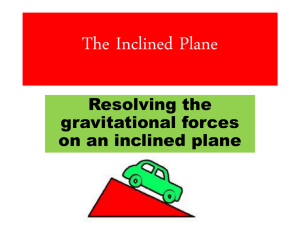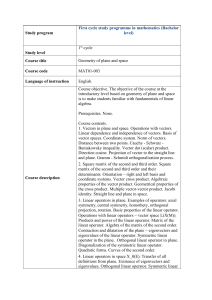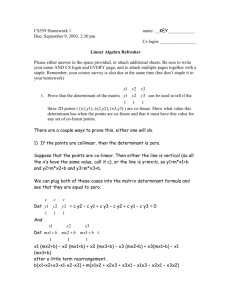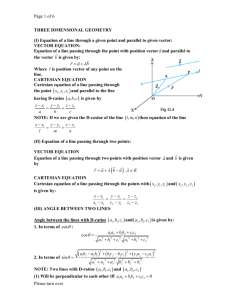Word version
advertisement
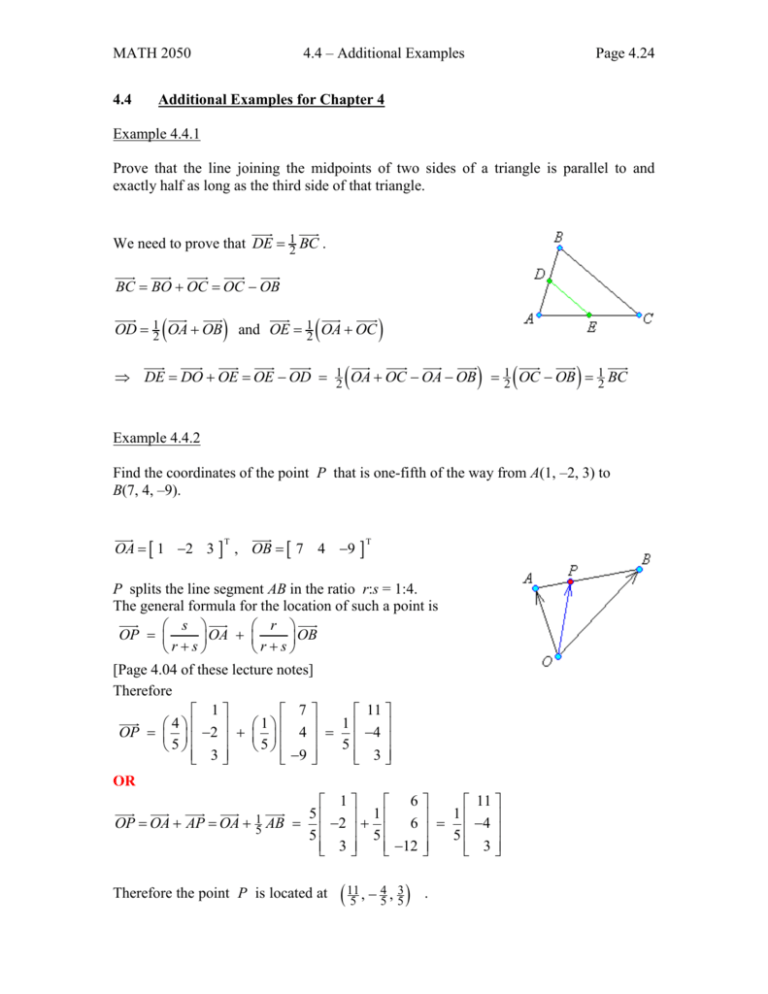
4.4 – Additional Examples MATH 2050 4.4 Page 4.24 Additional Examples for Chapter 4 Example 4.4.1 Prove that the line joining the midpoints of two sides of a triangle is parallel to and exactly half as long as the third side of that triangle. We need to prove that DE 12 BC . BC BO OC OC OB OD 12 OA OB and OE 12 OA OC DE DO OE OE OD 12 OA OC OA OB 12 OC OB 12 BC Example 4.4.2 Find the coordinates of the point P that is one-fifth of the way from A(1, –2, 3) to B(7, 4, –9). OA 1 2 3 , OB 7 4 9 T T P splits the line segment AB in the ratio r:s = 1:4. The general formula for the location of such a point is s r OP OA OB rs rs [Page 4.04 of these lecture notes] Therefore 1 7 11 1 4 1 OP 2 4 4 5 5 5 3 9 3 OR 1 6 5 1 OP OA AP OA 15 AB 2 6 5 5 3 12 Therefore the point P is located at 115 , 54 , 53 11 1 4 5 3 . 4.4 – Additional Examples MATH 2050 Page 4.25 Example 4.4.3 The points P(2, 3, 1), Q(4, 7, 2), R(1, 5, 3) and S are the four vertices of a parallelogram PQSR, with sides PQ and PR meeting at vertex P. Find the coordinates of point S. Following the path OQS: QS PR OR OP OS OQ QS 4 1 7 2 2 2 T T 1 2 2 T 3 9 4 T Therefore the point S is at (3, 9, 4). [One could follow the path ORS instead.] Example 4.4.4 Find the parametric and symmetric equations of the line L that passes through the points Q(1, –5, 3) and R(4, 7, –1). Find the distance r of the point P(2, –17, 10) from the line and find the coordinates of the nearest point N on the line to the point P. The line direction vector is d QR 3 12 4 T Either Q or R may serve as the known point on the line. Choosing Q, the vector equation of the line is x 1 3 p OQ t d y 5 t 12 , t z 3 4 The Cartesian parametric equations are x 1 3t , y 5 12t , z 3 4t , t from which the symmetric form follows: y 5 x 1 z 3 3 12 4 4.4 – Additional Examples MATH 2050 Page 4.26 Example 4.4.4 (continued) The vector from Q (a known point on the line) to P is v QP 1 12 7 T The shadow of this vector on the line is the projection 1 vd 1 u proj d v d 12 d 2 9 144 16 7 3 3 3 12 12 3 144 28 12 169 4 4 4 3 3 169 u 12 12 169 4 4 3 1 4 NP NQ QP u v 12 12 0 4 7 3 r NP 16 0 9 25 5 OR Triangle PNQ is right-angled at N 2 2 r 2 v u 1 144 49 9 144 16 25 The location of N can be found from 1 3 2 ON OQ QN 5 12 17 3 4 7 [or one may use ON OP PN instead] Therefore the point N is at (–2, –17, 7). r5 4.4 – Additional Examples MATH 2050 Page 4.27 Example 4.4.5 x 1 x 1 y0 z 1 y 1 z 2 and L 2 : are 2 1 1 2 1 3 skew and find the distance between them. Show that the lines L1 : Line L1 has line direction vector d1 2 1 3 and passes through point P1 (–1, 1, 2). T Line L2 has line direction vector d 2 2 1 1 and passes through point P2 (1, 0, 1). T Clearly d 2 is not a multiple of d1 . Therefore the two lines are not parallel. OR The angle between the lines, , is also the acute angle between the direction vectors of the lines. d1 d2 2 2 1 1 31 4 1 3 6 d1 4 1 9 14 , cos d1 d 2 d1 d2 d2 4 1 1 6 14 6 3 1 7 The lines are therefore at an angle of cos1 6 0 and 3 cos 1 0.65465 7 49.1 Upon finding a non-zero distance between the lines, we will complete the proof that these lines are skew. 4.4 – Additional Examples MATH 2050 Page 4.28 Example 4.4.5 (continued) The vector n d1 d 2 is orthogonal to both lines. The length of the projection of P1 P2 onto n is the distance r between the lines. ˆi n ˆj kˆ 1 1 1 1 3 ˆi 2 6 ˆj 2 2 kˆ 4 1 1 3 1 2 2 P1 P2 PO OP2 1 1 2 1 ˆ r proj n PP PP 1 2 1 2 n T 1 0 1 PP 1 2 n n T 2 1 1 2 1 1 4 1 1 1 4 1 2 12 12 T Therefore the distance between the two non-parallel lines is r 2 11 111 4 3 4 3 2.309 3 and the two lines are skew. Example 4.4.6 Find two non-zero vectors that are orthogonal to each other and to u 3 2 0 It is easy to construct a non-zero vector v whose dot product with u is zero: T v 0 0 1 v u 000 0 For the third vector, just take the cross product of the first two vectors: ˆi 3 0 2 0 ˆ 3 0 ˆ 3 0 ˆ w u v ˆj 2 0 i j k 2 ˆi 3 ˆj 0 kˆ 0 1 0 1 2 0 kˆ 0 1 Therefore v 0 0 1 T and w 2 3 0 T . T . 4.4 – Additional Examples MATH 2050 Page 4.29 Example 4.4.7 Find the Cartesian equation of the plane that passes through the points A(3, 0, 0), B(2, 4, 0) and C(1, 5, 3) and find the coordinates of the nearest point N on the plane to the origin and find the distance of the plane from the origin. Two vectors in the plane are u AB 1 4 0 and T v AC 2 5 3 . A normal to the plane is T ˆi 1 2 u v ˆj 4 5 kˆ 0 3 12 4 5 ˆ 1 2 ˆ 1 2 ˆ i j k 3 0 3 0 3 4 5 3 4 3 1 1 Therefore a normal vector to the plane is n 4 1 1 T a OA 3 0 0 n a 3 4 0 0 12 T The Cartesian equation of the plane is 4 x y z 12 The displacement vector for N is the projection of the displacement vector of any point on the plane onto the plane’s normal vector. OA n ON proj nOA OA nˆ nˆ n n 2 3 4 4 4 4 1 2 12 2 2 2 0 1 1 1 1 4 1 1 18 3 1 1 0 1 1 2 2 2 2 2 4 1 1 18 2 2 Therefore N is the point 83 , 32 , 32 and r ON 3 3 4.4 – Additional Examples MATH 2050 Page 4.30 Example 4.4.8 Find all vectors w that are orthogonal to both u 1 2 3 T and v 4 3 2 One vector that is orthogonal to both u and v is ˆi 1 4 2 3 ˆ 1 4 ˆ 1 4 ˆ u v ˆj 2 3 i j k 5 ˆi 10 ˆj 5 kˆ 3 2 3 2 2 3 kˆ 3 2 Any multiple of this vector is also orthogonal to both u and v . Therefore the set of vectors w is 1 2 1 t , T t . Check: T w u 1 2 1 t 1 2 3 1 4 3 t 0 t and T w v 1 2 1 t 4 3 2 T T 4 6 2 t 0 t Example 4.4.9 The vertices of a triangle ABC are at A(1, 0, 1), B(–2, –1, 1) and C(3, 2, 2) . Find the angle at vertex A (correct to the nearest degree). u 9 1 0 10 3 1 0 T v AC 2 2 1 v 4 4 1 9 3 T T u v 3 1 0 2 2 1 6 2 0 8 u AB T Let be the angle at vertex A, then uv 8 cos 0.84327 u v 3 10 147.4875 147 T . 4.4 – Additional Examples MATH 2050 Page 4.31 Example 4.4.10 (Textbook, page 179, exercises 4.2, question 18) Show that every plane containing the points P(1, 2, –1) and Q(2, 0, 1) must also contain the point R(–1, 6, –5). PQ 1 2 2 T and QR 3 6 6 T 3 1 2 2 T 3 PQ Points P and Q are in a plane all points on the line through P and Q are in any plane containing P and Q . But QR 3 PQ point R is on the line through P and Q Therefore every plane containing the points P and Q must also contain the point R. Example 4.4.11 (Textbook, page 180, exercises 4.2, question 44(a)) Prove the Cauchy-Schwarz inequality u v u Let be the angle between vectors u and v . u v u v cos , but cos 1 uv u v v . MATH 2050 4.4 – Additional Examples Example 4.4.12 Find the point of intersection of the lines x 1 y 6 z 7 . 1 2 3 Page 4.32 x 3 y 3 z 0 and 2 1 1 x 3 2s, y 3 1s, z 0 1s Line 1: x 1 1t , y 6 2t , z 7 3t Line 2: At the point of intersection x 3 2s 1 t 2s t 4 y 3 s 6 2t s 2t 3 z s 7 3t s 3t 7 Solving the over-determined linear system for s and t, 1 4 3 2 1 2 R1 R 2 R 2 2 R1 1 2 3 2 1 4 R3 R1 1 3 7 1 3 7 3 1 2 0 5 10 R3 R 2 0 0 0 1 2 3 R2 5 0 1 2 0 0 0 1 0 1 R1 2 R 2 0 1 2 s 1 and t 2 0 0 0 Unique solution a single point of intersection does exist. x 3 2 1 1 y 3 1 2 z 1 1 Therefore the two lines intersect at the point (1, 2, 1). 3 1 2 0 5 10 0 5 10



